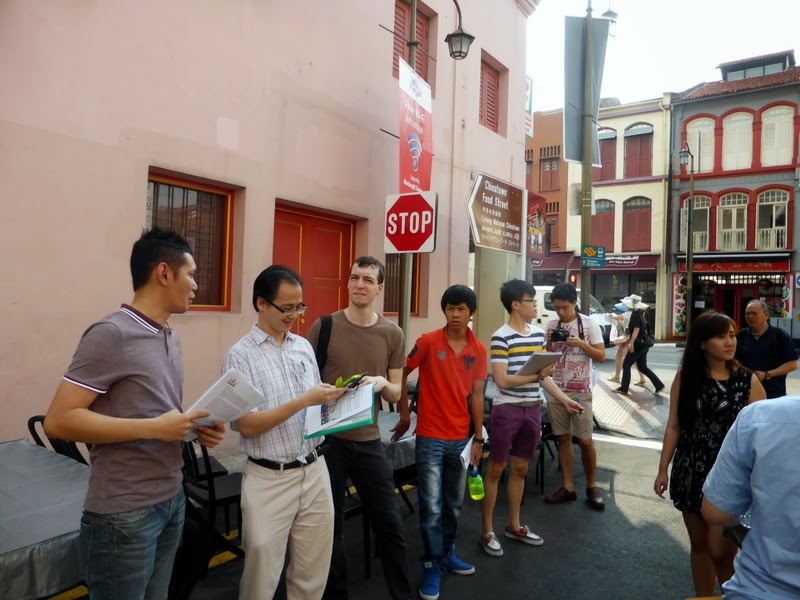Thian Hock Keng (Tian Fu Gong) at Telok Ayer St had come up with a bigger programme kicking off the festival with a performance by popular Taiwanese folk singer, Deng Zhi Hao on 19 Apr 2014. He last performed in this temple in 1996 and 2010. Both Buddhist and Taoist rituals were conducted during this celebrations. There was also a Hokkien Marionette on the 22 April morning followed by a Getai (variety show) in the evening.
For Wak Hai Cheng Beo (Yue Hai Qing Miao, also known as Yueh Hai Ching Temple), this year is special because the temple has just completed its restoration and the temple was in full splendour with the celebration that included a two day performance of the Teochew iron-stick puppet, a puppetry unique to the Teochews.
Away from Chinatown, there are many more Mazu temples and shrines celebrating. Across the Singapore River is the Hainanese Tian Hou Gong at Beach Rd (you have to enter the Hainan Association building to see the temple). Further inland are the Cantonese Mazu temples in Sin Ming Industrial Estate and Ang Mo Kio St 44 Avenue 10. In Geylang is the HengHwa (Putian) Mazu Temple.
Mazu temples can be considered as closely linked to the early Chinese arriving in Singapore. Mazu, known as Goddess of the Sea, with many titles bestowed by different Chinese Emperors, amongst them the most commonly known is Tian Hou (Heavenly Empress), was the Goddess whom the Chinese would pray to thank upon coming ashore. It is said that when Admiral Cheng Ho (Zheng He) came to Nanyang and the oceans as far as off the African coast, his big ships would have the statues of Mazu to guide and protect the ships, and to whom they could seek for help when encountering stormy seas.
Thian Hock Keng and Wak Hai Cheng Beo are possibly the oldest Mazu temples in Singapore. In the old days, as is now, these temples were built for their own communities, usually dialect or associated vicinities in China. Thian Hock Keng would be mainly for Hokkiens from Hokkien (Fujian), China. Wak Hai Cheng Beo would be for the Teochews, and for Cantonese too as one could see Cantonese Taoist Priests performing rituals in this temple (since they all come from GuangDong).
While the deity, Mazu, is one and the same, the Taoist rituals, the tradition and customs of offerings and even entertainment such as puppet show or opera are uniquely different. During the Mazu festival, if you are keen to observe the traditions of different dialect groups in their celebrations, visit all the different temples. The Hainanese temple would have their Hainanese rod puppet. The Cantonese would usually have Cantonese Opera.
I remember when I was very young, during Chinese New Year eve, my grandma and mum would bring me to Thian Hock Keng on a trishaw late into the night to offer our first joss sticks to Mazu, whom we affectionally called Ma Chor Po (literally translated as Grandma Mazu). And on Ma Cho See (Mazu Birthday) too. As kids we were not too keen to go because of the smoke from the burning joss sticks and joss papers. Today, there is almost an absence of it as the burning joss sticks were efficiently taken off from the joss urns after a couple of minutes, in some cases, seconds. While the form might change, the sense of belief remains as I observe the devotees prayed fervently, communicating with Mazu, privately one-to-one. During lunch time, smartly dressed office workers would come to the temple to pay their respects and seek blessings. Only Mazu knows the many requests made of her, be it blessing, solving of a problem, or to lend a listening ear.
These two temples, built in 1800s (Thian Hock Keng in 1842 and Wak Hai Cheng Beo in 1855), with a couple of restorations, are amongst the oldest in Singapore. Only they alone witnessed the changing tides of Singapore. The sea is no longer visible, surrounded by towering concrete blocks. But when you enter the temple courtyard you enter into another world, easily one that could be 150 years ago.














